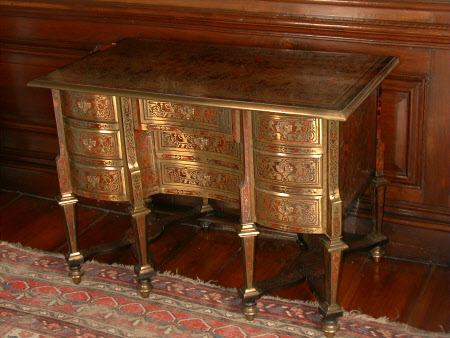Bureau Mazarin
manner of André-Charles Boulle the Elder (1642 - 1732)
Category
Furniture
Date
circa 1700
Materials
Brass inlaid tortoiseshell, deal construction, brass mounts, ebony
Measurements
77 x 105 x 58.5 cm
Place of origin
France
Order this imageCollection
Dyrham, Gloucestershire
NT 453124
Summary
A brass inlaid tortoiseshell and ebonised bureau a Mazarin, in the manner of André-Charles Boulle (1642-1732) Paris, circa 1700 The rectangular top with brass mounted edge and inlaid with a brass pierced panel centered by a pavilion with domed roof and garlands of flowers with birds, figures and urns below within borders or arabesques and scrolling foliage within an etched brass banded frame. The body with an arrangement of nine drawers, raised on square section tapered legs with brass square caps and tied by twin X stretchers terminating on brass bun feet. The sides panelled and inlaid with conforming boulle work decoration.
Full description
André-Charles Boulle (Paris, 1642 - 1732) was a French ebeniste who is generally considered to be the preeminent artist in the field of marquetry, his fame in marquetry work led to his name being given to the fashion he perfected of inlaying brass and tortoiseshell. In 1672, Boulle rose from master cabinetmaker to ébéniste du roi, royal cabinetmaker and sculptor to King Louis XIV, That same year, the king granted him the royal privilege of lodging in the Palais du Louvre. This position allowed Boulle to produce furniture as well as works in gilt bronze, such as chandeliers, wall lights, and mounts for furniture. Although strict guild rules usually prevented craftsmen from practicing two professions simultaneously, Boulle's favored position allowed him protected status and exempted him from these statutes. The furniture by Boulle was never signed and as a result, many of the pieces are noted as attributed rather than definitely by the artist. See Jean Nérée Ronfort (ed.), 'André Charles Boulle, 1642-1732 : Un nouveau style pour l’Europe' Frankfurt 2009 for Boulle's work and discussion. (James Weedon 2017)
Provenance
Dame Joan Evans' bequest No.8.
Makers and roles
manner of André-Charles Boulle the Elder (1642 - 1732), ébéniste
References
Ronfort 2009: Jean Nérée Ronfort (ed.), André Charles Boulle, 1642-1732 : Un nouveau style pour l’Europe (ex. cat.), Frankfurt 2009
